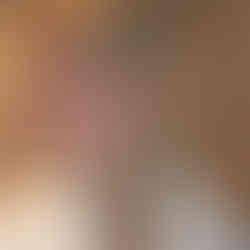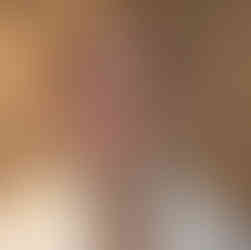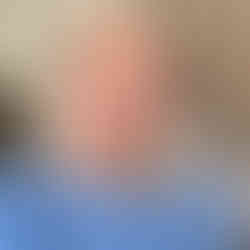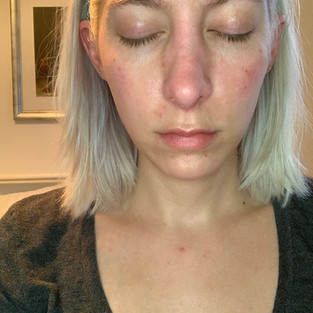How I transformed my skin
- Claire

- Sep 19, 2020
- 8 min read
For someone who has loved skincare her entire life it's pretty shocking how long it took me to get my own skin in a good place. As a teen I suffered from a "normal" amount of acne on my face but a highly abnormal amount on my back - so much so I eventually turned to accutane to solve the issue. As I grew older I also grew frustrated and confused as to why I still experienced acne. Like most people, I was told that pimples were a problem for teenagers, one that would be gone by adulthood. But at 29, I was still suffering. If you happen to be a teenager reading this, let me tell you what no one told me: acne isn't just for teens. Everyone, of all ages, gets it. It can even show up for the first time late in life. So if you are a unicorn of a 16 year old with blemish free skin, don't get too comfortable. You might get a lovely bout of cystic acne at age 30 because life is cruel. Knowing this, there is no better time to start taking care of your skin than right now.
Here is my skin August 2018 - you can clearly see redness, irritation, breakouts, and melasma on my forehead.
Looking back, I committed countless sins to my poor skin. Below is a non-exhaustive list of the myriad of things I put my skin through from my teens well into adulthood:
Never wearing sunscreen
Sleeping in makeup
Using makeup wipes
Using harsh scrubs like St Ives Apricot Scrub
Pore Strips
Endless hours in front of the mirror picking at my face
Getting sunburnt
....and then peeling off my burnt skin
Never reading an ingredient list, let alone researching the ingredients
Using something soley because it "smelled good"
Buying a Clarisonic, the Deep Pore brush head, and using it every.single.night.
Avoiding oils of any kind
Only using products designed for treating acne
Endless charcoal masks
Using P50 every night regardless of how red and irritated my skin became
Constantly trying new products
The list could go on for ages. So let's talk about how I turned it around and got to where I am today - a glowing goddess who barely wears foundation because she loves how her skin looks so much.
First, I found out what my skin type was. I know. This sounds so obvious. But I went my whole life thinking I had oily skin simply because I had acne! In my early twenties my mom bought me a gift certificate for a facial at a medical spa I still go to occasionally, Lincoln Park Aesthetics. I'd had facials before sporadically when I was a teen to try and tackle some really bad breakouts, but never from a medical spa. I will never forget the sigh of frustration that came out of my aesthetician, Michelle's, mouth as she went in with yet another layer of product. "You have the driest skin I have ever encountered. I've had to use three times the amount of product I normally use on you, and your skin still isn't responding. It's going to take a lot of work to repair this." It sounds harsh but she didn't intend it to be mean - she was just shocked and frustrated - and rightfully so. I'd been abusing my skin, informed by bad advice from magazines instead of skin professionals. She knew I was a broke recent college grad who couldn't afford to come see her monthly like she recommended, so instead she told me to throw away everything I was using and asked me what I could afford to spend on a few products. She selected three for me to start using to help heal my badly compromised skin. I gawked at the name of the first one: Medical Barrier Cream. It was a very thick and rich moisturizer - something I previously thought was the exact opposite of what I should use. She assured me I needed it. "You have dry skin. You're breaking out because your skin is so unbalanced. It needs moisture and hydration, not acne treatments." She rounded out the selection with a gentle creamy cleanser and hydrating, balancing toner. All were fragrance free, which is another thing she told me I should start avoiding to give my skin a break and eliminate any possible irritants.
I wish I could tell you I listened to her and was religious about following her instructions, but ever lured by social media, glossy magazines and Sephora reviews, I strayed. I did use the products she recommended, but now armed with the knowledge I had dry skin, I kept searching for "miracle" products. It wasn't until I was 29 did I finally admit I had no idea what I was doing, and sought advice from a dermatologist. Here is what she told me:
My dry skin was also very sensitive and the chronic redness I was experiencing wasn't always irritation from products, it was rosacea.
She also diagnosed me with melasma, which is pigmentation due to things like sun exposure, or in my case, hormonal birth control. It's hard to eliminate and comes back easily and quickly.
She prescribed me EpiduoForte, an Adapalene (Vitamin A/retinoid) focused topical treatment as well as a sulphur face wash and a benzoyl peroxide body wash. I'd tried similar retinoid products when I was younger and they helped a lot, but I'd stopped using them years prior.
For my melasma she gave me hydroquinone cream, which is a skin lightener. She told me if it didn't work we could try laser treatments but warned me they are expensive and 10 minutes of sun exposure could undo all the hard work we'd done, so she also advised to start wearing tinted SPF religiously as the tint helps prevent melasma. She recommended EltaMD UV Clear Tinted SPF - which is now my holy grail SPF.
Lastly, she recommended to use a simple but very effective moisturizer that my dry, sensitive skin would love, Avene's Skin Recovery Cream. To this day, this is my favorite moisturizer, ever. I have gone through at least six tubes.
She told me to be patient, and sent me on my way. It was a grueling 4 months of purging. Purging, if you do not know, is a real thing. A new product, especially one like a retinoid, will stimulate new cell turnover which will eventually reveal healthier skin. But only after first "purging" all of the built up gunk that has been accumulating deep under the surface. It ain't cute. Basically, just expect things to get much worse before they get better. But stick with it, because it DOES get better, so so much better.
The above photos are February 2019. On the far left you can see my skin was in a decent place, but my (undiagnosed) rosacea was still prevalent on my nose and cheeks, and my melasma was quite dark. The next two photos show a particularly bad flare up that led me to seek professional help.
After about six months of my new routine, my skin was leagues better. I was virtually acne-free (minus the occasional hormonal breakout), and my rosacea was significantly less noticeable. My melasma, however, wasn't budging. It was around this time SpaDerma, a local medical spa, invited me in for some treatments. My aesthetician, Dana, advised chemical peels. I documented the process on my instagram highlights, and loved every second of it. I treated myself to a bundle of three, and went in again about six weeks later. (COVID has since stopped me from getting my next two, but I will go back soon!) The chemical peels jumpstarted my melasma eradication.

In the down time between treatments, I discovered an acid exfoliator that changed my life. The Gentle Resurfacing Liquid from Deviant Skincare was the gentle but effective acid product I'd hoped P50 would be. I began to use it a few nights a week (never on EpiDuo nights), and my melasma finally started to fade. The combination of retinol, acids, with occasional chemical peels was the magic formula for my melasma. Now, it's not 100% gone, but it has faded significantly to the point I hardly notice it anymore.
I also paired down the rest of my routine and stuck to it. I stopped constantly trying new products. My skin needed the chance to heal and for that I needed to stop exposing it to new things all the dang time. That being said, I was meticulous and exceptionally picky about what I used, and I also splurged on a few promising products. I achieved my ideal routine by reading lots of research on ingredients, and always reading every product label before trying it. Whenever I did not know an ingredient, or what its purpose was, I used this Ingredient Decoder site to help me understand. After time, I learned what ingredients my skin liked and responded to, and which I needed to avoid, such as fragrance and coconut oil. I now have a nice arsenal of products I am comfortable and confident in using. Obviously, as a content creator who talks primarily about skincare, I do still test new products. But I am even more selective than ever with what I will test, and I refuse to test more than two things at a time. Here is short rundown of what my routine looks like now:
Morning:
Cleanse with a gentle milk cleanser
Mist or pat in a hydrating essence
Vitamin C Serum
Hyaluronic Acid Serum
Eye Cream
Mist again
Moisturizer
SPF
In the winter I will add an oil before the moisturizer
Evening:
First cleanse with a balm or oil to remove makeup/SPF using a soft washcloth and warm water
Second cleanse with a gentle, milky, hydrating cleanser
On retinol nights: apply EpiduoForte to dry skin
On acid nights: mist then apply AHA/BHA toner or serum
A BioSerum
Rich Moisturizer
In the winter I will add an oil before the moisturizer
There are also some non-skincare life changes I made to help get my skin on the right track. I recognized my skin is an organ, and while diet and lifestyle changes won't alter my genetics, they could help my skin function at optimal levels. Here's what I think helped the most:
Drinking more water
Eating a balanced diet (this is a constant work in progress)
Managing stress levels with things like yoga 3 times a week
Eating less refined sugar
Taking vitamins & supplements daily
Getting enough sleep
Even with all this progress, life will still always throw curveballs. This past spring I decided to go off birth control for some health reasons. One of the positive side effects of hormonal birth control is clearer skin - so when I made the decision to stop taking the pill my first thought (vainly) was of my skin. While I did not notice much of a change with the acne on my face, my body acne swiftly crept back and within three weeks my entire back was covered in painful spots. I met with my dermatologist and she wrote me a prescription for Spironolactone, which targets the horomonal causes of acne. I've been on it for almost 4 months, and I am finally noticing a difference.
So....yeah. I have been doing a lot. Clear skin isn't a sprint, it's not even a marathon - it's a lifelong commitment to making the right choices over and over again. All in all, I would say getting my skin to where it is now took almost a year. I saw noticeable improvements after four months, and there have been setbacks along the way. If you need a TLDR version of my steps, here it is summed up:
I learned what my skin type actually was
I stopped using products that only focused on a problem (e.g., acne) and started using products that were aimed at making my skin healthier overall
I sought help from professionals and stopped listening to magazine and Sephora reviews
I started learning as much as I could about ingredients
I minimized my routine and kept to it consistenly
I made slight adjustments to my routine to cover seasonal changes
I invested in specialized treatments to target my stubborn problems
I made lifestyle changes to support my overall health
I was patient and consistent
The above images are of my skin makeup free (except mascara in the first two, tinted SPF in the middle) this past summer - 2020. You can clearly see my melasma is dramatically reduced, acne is mostly eliminated, and my rosacea is only on the apples of my cheeks (honestly it kind of looks like blush and no longer bothers me).
I plan to follow this blog up with a dedicated list of all the specific products I attribute to the success of my skincare journey, so be on the lookout for that soon. But remember, what worked for me might not work for you. I am not a dermatologist, aesthetician, or skincare specialist. I'm certainly a skincare enthusiast and I am sure a lot of what helped me could potentially help you as well! Just take your time, learn as much as you can, and seek help from professionals if you are able. I hope this post was helpful! Thank you for reading.
Cheers,
Claire

























Comments